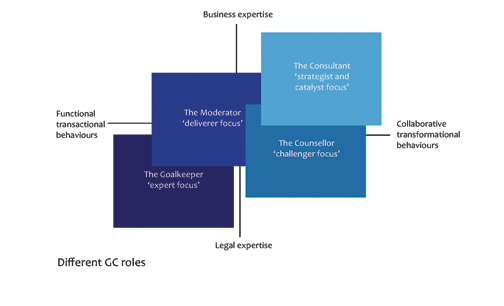I meet and spend time with many GC’s from both large, and not so large, organisations. It can be an enriching experience, and though I’ve had the odd crippling disappointment, I enjoy the learning I always gain. Let’s face it – these are, quite frankly, privileged interactions. Recently I had a meeting with a highly respected and well-regarded GC who leads the legal function for a major FTSE 100 company. I hadn’t spoken with them before and had been looking forward to our meeting, as they’ve been written about by others and identified as a role model for those in-house. It took an age to get access and then to finally get the meeting scheduled. To say I was filled with anticipation would be an understatement.
They were as amicable, sharp and interesting as I could have hoped. They were witty, engaging and likable. In short I liked them, respected them and look forward to meeting them again. But the meeting left me puzzled: What they said they do didn’t match what they actually did, and what they articulated about how they operated, didn’t match who they were.
Let me explain what I mean.
They used the word ‘value’ a lot. They, their team and their function ‘added a lot of value’, they ‘delivered value’, they ‘contributed value’ and so on. That’s great and let’s face it, who wouldn’t want that? But how it was done was a little less convincing.
Their methodology was described as an ‘ongoing reduction in costs of our service delivery operating model, delivered in tandem with deliberate productivity enhancements’. If we’re honest, that’s just a fancy way of saying we’re ‘cost cutting’ our service while delivering the same quality. Is that adding value? In the broadest sense it is – but it’s not massive in terms of impact. The service the organisation gives to its customers won’t change as a result of this. The organisational margin, outside the costs of the in house department, won’t be influenced as a result of this. So personally I’d say ‘adding value’ is a bit of a stretch.
Beyond the margins
To illustrate, let’s think about it another way. I can buy a bag of own brand peas from my local supermarket, use them to feed my family and save a few pennies from buying the equivalent well known consumer brand peas. Have I really ‘added value’ to my family? Seems I’m saving a few pence which no one will notice as they devour a mouthful of petit pois while watching ‘Game of Thrones’. However, if I was doing that systematically, using the savings for some other purpose, then a more value adding case builds.
Taking this back to my conversation with the GC, I asked a ‘so, tell me why you’re buying cheap peas?’ question. The problem was, the answer they gave never suggested it was for any reason other than being able to demonstrate a lower annual shopping bill. There was no ‘it means we can reinvest energy in developing the organisation’s strategy in ‘X’, or we can help enhance our organisations service in ‘Y’. It was solely to demonstrate lower costs and efficiency. Sure it is ‘adding value’ in the sense the cost of service is lower, but that really is the first and lowest rung on the ‘adding value’ ladder.
(Hughes & Trinder-Randle, 2016 Copyright Cranfield School of Management)
I then used a different angle: ‘What areas do you think you and your team impact the organisation the most?’ ‘We work hard to be available across the organisation. To be ready, to be helpful, and to be customer focused – that’s how we can really make a difference’. I probed, ‘And how does that contribute to either the top line or the bottom line?’ ‘Ah, well, that’s the question!’ was the answer. Ah, indeed. I now had a hunch the type of GC I was talking to. I tested this with my next question. How easy has it been for you to make that focus work within this organisation? ‘That’s interesting that you’ve asked that, because it hasn’t been. There’s quite a lot I’ve had to challenge’.
My next question was deliberate and focused. ‘Does this impact the time you have for getting under the skin of the organisation? Its services and so on? How do you make sure you still have time for that?’ ‘You know, that’s the area I struggle with. How did you know to ask about that…?’ ‘Because I’ve seen the approach you’ve taken before’ I answered, honestly. And that approach has a name: ‘The Counsellor’. It’s not what you say that defines you as an in-house lawyer, it’s what you do.
The counsellor
Those who fit the Counsellor mould are typically engaged by challenging the norms. They tend to look for different approaches or ways of doing things, in particular around the delivery of service, which leads them to break down what are often invisible, but meaningful barriers that exist between in-house and other functions. The Counsellor has a knack for looking for different ways of approaching problems and opportunities; that makes it easier for them to see past formal organisational structures and barriers.
They see solutions in light of different contexts, and are less requiring of a best practice approach. They are willing to be creative and like experimenting. They also like challenging others and trying different styles and approaches. However they are less inclined to fully immerse themselves in the organisation as a series of ‘systems’. They are also less likely to evaluate the organisation’s strategy and think, ‘Hmmm, it’s okay…but I think it needs more work in…’. Instead they will know it, but will not critique it in a meaningful way.
In short, they work hard at engaging with the business. But they could go even further by allowing themselves to grow their business expertise and understanding. The way they align with the business could be more impactful. Their collaborative transformational behaviours are good, but their business expertise could be better. And in helping Counsellors make that transition lies a valuable conversation and set of steps for them to make that change in their practice.
Moving forward
The GC I had been talking to needs help to find the best way to be more understanding of his own organisation. That will give them insight into how the increased efficiencies and productivity savings they are producing aren’t just saving costs of delivery, but are contributing to the delivery of value to their organisation.
The Counsellor I met has no concerns about the problems that pursuing a Best Practice approach to improvement can bring. Sure, you can bring in fresh perspectives and ideas. But you also risk ‘tissue rejection’ if what you transplant wasn’t the right treatment. But the Counsellor is very happy challenging the status quo and trying out new and untested approaches. In fact that willingness to be creative in how things are done, and identify new ways of working are all part of the strengths that this GC brings and others like them we have met bring too.
The way you act and behave as an in house lawyer, while influenced by your surroundings, is mainly down to you. The regular and sharp eyed among you will have seen the pattern of this overarching theme emerging as I’ve compiled these articles. Because we’re now at the stage where we can tackle the most fundamental and important question of all: who do you want to be and what does that mean for you?


